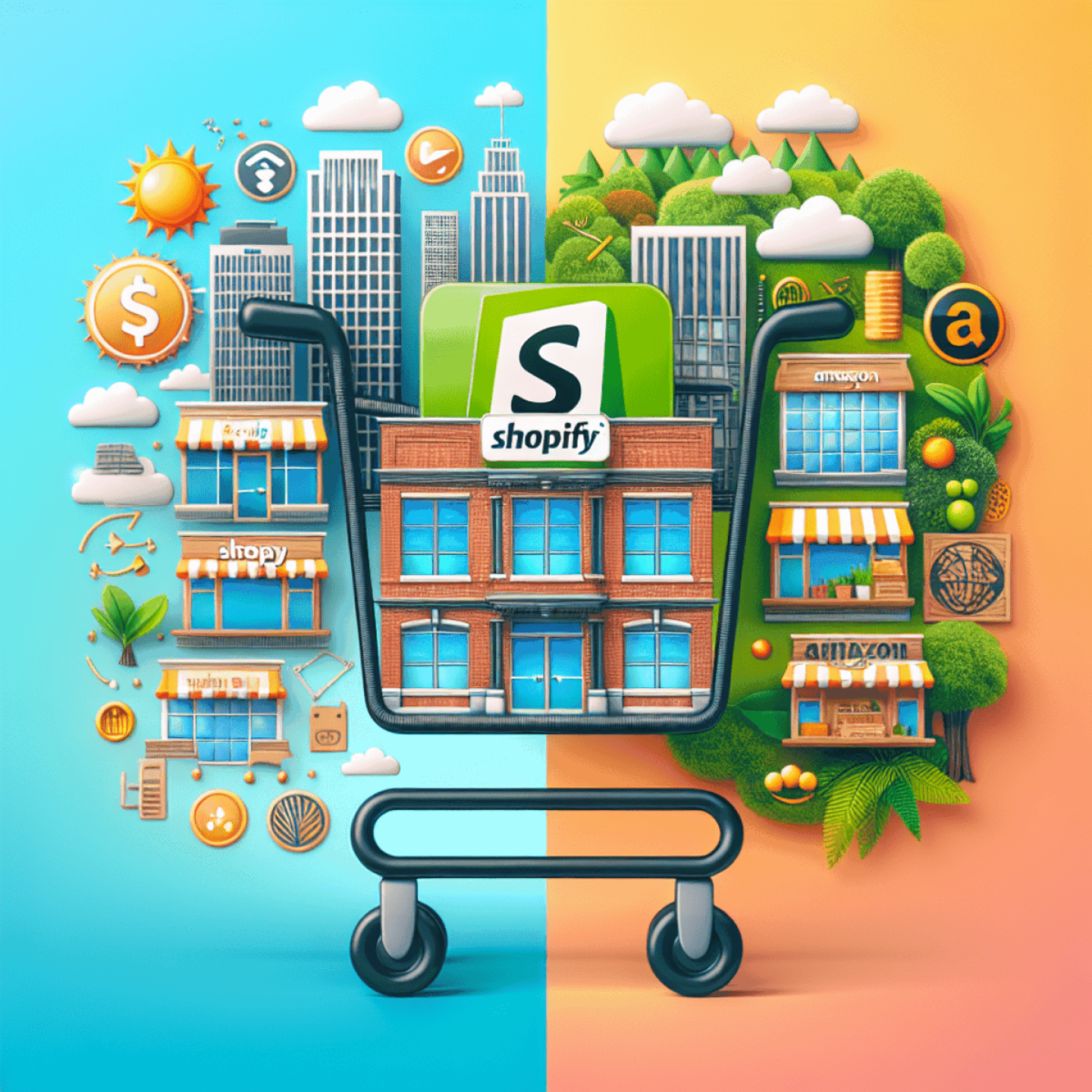
Our dropship tool integrates with Shopify and Woo-Commerce stores and automates your entire dropshipping business!
Get StartedIn the competitive world of online selling, choosing the right platform is crucial. The two main players in this game are Amazon and Shopify. While Amazon boasts a massive customer base, Shopify offers extensive customization options. Both platforms have their advantages for sellers.
As e-commerce continues to grow rapidly, more and more businesses are eager to get a piece of the action. However, an interesting trend has emerged: some sellers are shifting away from Amazon towards Shopify. This might seem counterintuitive considering Amazon's size and reputation.
But upon closer examination, it becomes clear that Shopify has some unique benefits that are attracting these sellers. In this article, we'll delve into why this shift is happening and how you can leverage Shopify to help your business thrive.
For those seeking an all-in-one solution to find popular dropship products and manage their online store, Anstrex Dropship can be an invaluable tool. Furthermore, if you're looking to streamline your dropshipping business even further, consider following these five simple steps to automate various aspects.
By gaining a comprehensive understanding of what each platform has to offer - Shopify vs. Amazon - you'll be able to make an informed decision for your business based on its specific needs and goals.
Choosing an e-commerce platform that suits your business's specific needs is a crucial decision. This choice can greatly affect how efficiently your online store operates, the experience it provides to customers, and ultimately, how profitable it becomes. Here are key reasons why this decision is so important:
Your choice between Shopify, Amazon, or another e-commerce platform lays the groundwork for your online business. It's essential to carefully evaluate each option to make sure it meets your current needs as well as future requirements as you strive for growth and success in the competitive world of e-commerce.
Shopify is an e-commerce platform known for its Software-as-a-Service (SaaS) model. It offers business owners a comprehensive system to create online stores. What sets Shopify apart is its ability to be highly customizable, allowing you to tailor your store according to your brand's identity and stand out in a crowded market.
One of the key strengths of Shopify is its flexibility, which enables sellers to customize their online storefronts extensively. Here are the main ways you can personalize your store on Shopify:
Choose from a wide range of free and premium themes that serve as the foundation for your store's design. These themes can be modified extensively to match your brand's image perfectly.
The Shopify App Store offers thousands of apps that can enhance your store's functionality. Whether you need advanced product options, loyalty programs, or live chat support, there's likely an app available for it.
If you have coding knowledge or access to developers, Shopify allows you to directly edit HTML, CSS, and JavaScript. This level of control ensures that every aspect of your store's design and functionality can be customized.
Shopify Plus users have the additional benefit of being able to customize their checkout experiences. This feature allows you to create a seamless shopping journey that can potentially increase conversion rates.
With these customization options, Shopify caters to both tech-savvy users and those without coding skills. Its user-friendly interface and tools make it possible for anyone to create an online store that truly represents their brand.
By leveraging Shopify's customization features effectively, businesses can:
Compared to other e-commerce platforms, Shopify's focus on customization encourages innovation and creativity among business owners. It removes the common technical barriers found on other platforms, empowering sellers to bring their visionary ideas to life.
This adaptability is crucial as it allows businesses to build customer-centric shopping experiences that attract and retain audiences. Ultimately, Shopify provides the necessary tools to establish a compelling online presence tailored to your specific business needs and customer expectations.
By utilizing these customization features strategically, businesses can establish a strong online identity that carries through every aspect of the user journey—right from the first click to the post-purchase follow-up. In doing so, you lay the groundwork for enhanced engagement and sustained growth in the competitive landscape of e-commerce.
One of the key features that Shopify offers is the ability to sell across multiple channels. With Shopify, you are not limited to just your online shop. You can diversify your sales avenues by branching out onto various social media platforms and other online marketplaces.
For example, Shopify integrates seamlessly with platforms such as Facebook, Instagram, Pinterest, and even Amazon. Therefore, it allows you to reach a wider audience and diversify your customer base. This multi-channel selling support makes Shopify a versatile platform for sellers looking to expand their reach.
You can create a fully integrated shop on your Facebook page where customers can browse and buy products without leaving the platform.
By tagging products in your Instagram posts and stories, you can lead interested viewers straight to your product pages.
If you want to leverage the immense customer base of Amazon while enjoying the customization features of Shopify, this integration allows you to sync your products and manage orders from both platforms in one place.
Apart from these numerous selling opportunities, another significant advantage of using Shopify is the Partner Program. By joining this program, business owners get access to exclusive resources like marketing materials, priority support, and even lead generation tools. The Partner Program empowers businesses to grow by providing them with resources that might otherwise be out of reach for small businesses.
This dual benefit of multi-channel selling support and partner program perks makes Shopify a compelling choice for online sellers eyeing expansive business growth.
If you run an online store, you know how important it is to market your Shopify store and optimize it for search engines (SEO). Many business owners don't realize that having a solid content plan can greatly improve visibility and drive sales for their e-commerce business.
Here are some key SEO strategies to implement on your Shopify store:
In addition to SEO, here are some effective content marketing strategies specifically tailored for Shopify stores:
By combining these SEO tactics with a strong content strategy, you'll be able to attract more organic traffic to your Shopify store, increase conversions, and achieve sustainable business growth.
Effective landing page optimization is crucial for maximizing conversions on your Shopify store. Once you've attracted potential customers to your site with compelling marketing strategies, your landing pages play a crucial role in their decision-making process.
The design of your Shopify landing pages should be clean, simple, and easy to navigate. A cluttered or confusing layout can quickly discourage visitors and decrease the chances of conversion.
Your headlines should be clear, concise, and create curiosity or urgency in the visitor's mind. They need to instantly convey the value of your product, making the visitor want to learn more.
Visual content is essential for creating an immersive user experience. Use high-resolution images that accurately showcase your products and resonate with your target audience.
Your CTA buttons should be prominently displayed and easily recognizable. Use persuasive language that motivates visitors to take immediate action - whether it's adding a product to their cart or signing up for a newsletter.
Customer testimonials, reviews, and ratings can significantly enhance credibility and trust in your brand. Highlighting positive feedback from satisfied customers can greatly increase conversion rates.
Slow loading speeds can lead to visitors leaving your site before even exploring what you have to offer. Make use of Shopify's tools for optimizing image sizes and reducing script usage to improve loading speed.
By focusing on these key strategies when customizing your Shopify landing pages, you can create a user experience that effectively converts visitors into customers.
When it comes to e-commerce business, Amazon is a force to reckon with. As a platform, it has redefined the rules of online selling and purchasing, making it a significant player in the global e-commerce landscape.
One of the most compelling reasons to sell on Amazon is its vast customer base. With millions of active users worldwide, Amazon offers an unmatched opportunity for sellers to reach a diverse audience.
"Amazon has established a strong reputation over the years." - Source
Amazon’s marketplace is not just vast; it's also diverse. It caters to different industries and sectors ranging from fashion and electronics to home goods and groceries. This diversity presents sellers with numerous opportunities for product diversification and business growth.
"Amazon provides sellers with valuable data-driven insights that can guide your market expansion strategy." - Source
As you navigate the e-commerce landscape, understanding the role of Amazon can help shape your online selling strategy. From its vast customer base to the potential for business growth, Amazon provides various opportunities that can be leveraged for success in the e-commerce space.
Managing logistics can be a complex task, especially as you scale your operations. Fulfillment by Amazon (FBA), however, offers a streamlined solution to handle the warehousing, picking, packing, shipping, and customer service for your products.
To maintain the high standards expected by Prime customers, your products must meet specific criteria:
By leveraging FBA, sellers can focus more on their product and less on the minutiae of order fulfillment. This level of support is essential for businesses aiming to grow within the competitive space of online marketplaces like Amazon.
Amazon's comprehensive ecosystem provides sellers with a variety of advertising options that can significantly bolster their ecommerce business. One such example is pay-per-click (PPC) advertising, an efficient method for sellers to promote their products directly to Amazon's vast customer base. Through PPC advertising, sellers can maximize product visibility and drive targeted traffic to their listings.
Meanwhile, Seller Central is a key tool that enables sellers to manage their business on Amazon. From listing products, tracking sales, managing orders, to accessing performance metrics – Seller Central is your dashboard for all operational aspects of your Amazon business. This platform also provides access to Fulfillment by Amazon (FBA), enabling you to streamline order management and fulfillment processes.
It's important to note that while these tools offer great benefits for expanding your market presence and visibility, they also have some downsides. Increased competition on Amazon means you'll need a well-optimized listing and a smart PPC strategy to stay ahead.
In the next section, we will explore why some sellers are choosing to move from Amazon to Shopify despite these powerful tools provided by Amazon.
As the e-commerce landscape evolves, sellers are reevaluating their platform choices. A significant wave of sellers is gravitating towards Shopify from Amazon. This shift can be attributed to several factors, primarily focusing on branding opportunities and unique value proposition that Shopify offers.
Shopify stands out as an excellent platform for sellers looking to establish a strong brand identity. Unlike Amazon, where numerous products compete for visibility, Shopify gives you a dedicated space to showcase your brand and products.
By allowing full customization of storefronts, Shopify empowers sellers to effectively communicate their UVPs. This could mean crafting compelling product descriptions, showcasing high-quality product images, or even creating engaging video content.
A robust content strategy plays a crucial role in building a unique brand on Shopify. A well-executed content strategy can help drive traffic, increase customer engagement, and boost conversions.
While Amazon's vast customer base is a significant advantage, the opportunity to build a unique brand and execute effective content strategies on Shopify is attracting more sellers. The next sections will explore this shift in more detail, focusing on cost-effectiveness and community support offered by Shopify.
In the Shopify vs. Amazon debate, one vital aspect that weighs in favor of Shopify is the potential for lower costs. The e-commerce platform has a transparent pricing structure with plans starting from $29/month. While transaction fees do apply for non-Shopify Payments transactions, they can be as low as 0.5% for the Advanced Shopify plan, which is significantly lower than Amazon's referral fee that can reach up to 45% depending on the product category.
Another cost-related factor is marketing. With Amazon, sellers often need to invest heavily in advertising to stay ahead of the intense competition. In contrast, Shopify allows sellers to leverage organic traffic through SEO and content marketing strategies - a cost-effective approach for driving customer acquisition.
Making 100K with Shopify is not an unrealistic goal when considering the reduced competition on the platform compared to Amazon. Unlike Amazon's marketplace where millions of sellers vie for customer attention, Shopify gives merchants their own standalone online store. This setup opens up opportunities for niche targeting, allowing businesses to create unique branding experiences tailored to a specific audience.
One illuminating example is Gymshark, a fitness apparel brand that started as a small Shopify store and grew into a global brand generating over $100 million in revenue.By focusing on their unique value proposition and leveraging content strategy for e-commerce, businesses can carve out their own space in the market without being overwhelmed by larger competitors.
While both platforms have their merits, these factors are certainly an overview of the reasons driving sellers to abandon Amazon in favor of Shopify.
In the world of online selling, having community support is crucial for the growth and success of your business. When comparing "Shopify vs. Amazon", one big difference is how each platform builds and supports its community.
The Shopify Partner Program is an amazing initiative created by Shopify to empower entrepreneurs, digital marketers, and developers. This program gives you the tools you need to build your business and increase your earnings. It includes:
These benefits have led to many success stories of entrepreneurs earning 100K with Shopify through clever branding strategies and effective content plans.
On the other hand, Amazon mainly focuses on keeping its customers happy and doesn't have a similar partner program. However, they do offer an affiliate program where you can earn commissions by promoting Amazon products.
When it comes to community support, Shopify stands out with its active forums where business owners share tips, give advice, and provide valuable insights based on their own experiences in the world of online selling. This supportive community can be extremely helpful in refining your branding and content strategy for e-commerce.
Considering these factors, it's clear why some sellers are choosing to move away from Amazon and towards Shopify. In the next section, we'll take a closer look at what factors you should consider when deciding on an e-commerce platform that fits your business goals.
Selecting an e-commerce platform is a crucial decision that can greatly impact your business growth strategy. When deciding between Shopify and Amazon, there are several factors to consider, each important in line with your specific business goals.
This decision not only affects your current operations but also determines how you'll expand in the future. Each platform has its own advantages tailored to different seller needs — thorough research and careful consideration will lead you to the right choice for your e-commerce journey.
The Shopify vs. Amazon debate presents a crucial decision for online sellers. Each platform has distinctive benefits tailored to different business models and goals. Shopify excels in customization, brand identity, and multi-channel selling, offering a canvas for creative and strategic freedom. Amazon, with its vast customer base and streamlined fulfillment options, serves as a powerhouse for exposure and convenience.
As you weigh your options, consider the long-term vision for your brand. If establishing a unique presence and cultivating direct customer relationships is at the core of your strategy, Shopify may align closely with your aspirations. Conversely, if leveraging an established marketplace to quickly reach a wide audience fits your plan, Amazon could be the suitable choice.
The e-commerce landscape is dynamic, and success often hinges on adaptability and informed decision-making. By analyzing these platforms through the lens of your own business requirements, you position yourself to harness the respective strengths of Shopify or Amazon effectively.
Remember that your journey doesn't have to be exclusive to one platform—many businesses thrive by utilizing both in a complementary fashion. As the market evolves, stay attuned to shifts in consumer behavior and technological advancements to continually refine your approach.
Shopify vs. Amazon—the right choice is unique to each seller's journey.
Receive top converting landing pages in your inbox every week from us.
Tips & Tricks
Smooth fulfillment is the key to a successful holiday dropshipping season. Discover seven practical tips to streamline your operations, manage shipping delays, and keep customers happy during peak demand. Learn how to coordinate with suppliers, optimize inventory, and ensure timely deliveries. Perfect for dropshippers aiming for a stress-free and profitable holiday rush.
Dan Smith
7 minDec 13, 2025
Announcement
Stay ahead of the competition with the top dropshipping trends set to dominate December 2025. From trending products to automation tools and marketing tactics, discover what’s driving the next wave of eCommerce success. Learn how to adapt your strategy to meet shifting consumer demands and boost year-end profits. A must-read for dropshippers preparing for a high-performing holiday season.
Dan Smith
7 minDec 5, 2025
Trending
This blog explores how strategic influencer collaborations can turn ordinary dropship campaigns into viral successes. It highlights how to choose the right influencers, craft authentic partnerships, and create engaging content that resonates with target audiences. Readers will learn proven tactics for boosting brand awareness, driving sales, and building credibility through influencer marketing. A must-read for dropshippers looking to scale their business with social media influence.
Rachel Thompson
7 minNov 18, 2025




